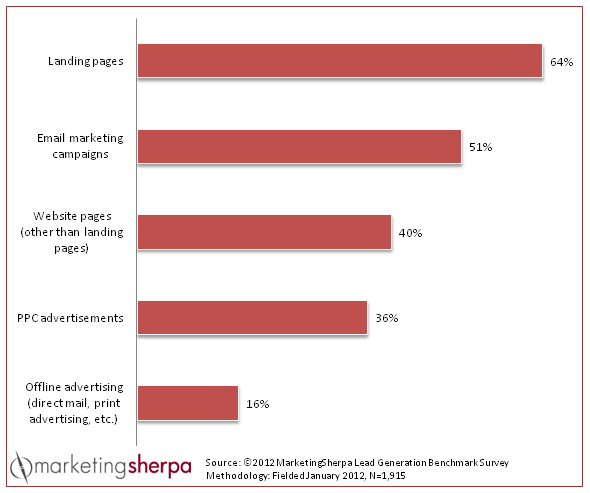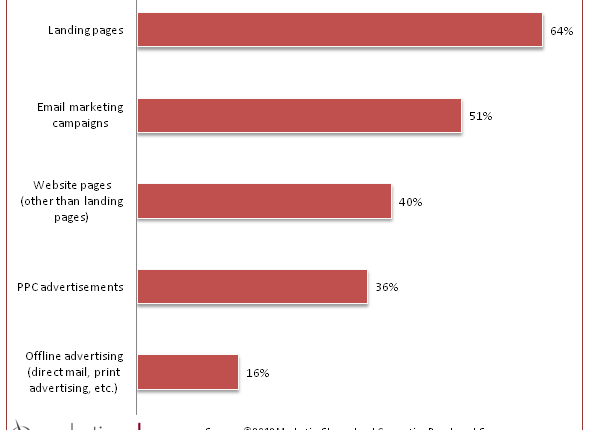We surveyed 1,915 marketers for the MarketingSherpa 2012 Lead Generation Benchmark Report, and asked them which methods were most effective for testing value propositions. Here is what the data says …
Q: Which methods have been the most effective at testing your value proposition? Select up to three responses.

What about live interviews?
Lisa Dennis, President and founder, Knowledgence Associates, said, “All good information, but one area that has been overlooked here is testing by conducting live interviews with two key groups.”
Those groups are:
1. Your existing customers
2. Your salespeople
Lisa has found that these types of conversations provide important information on the following:
- What resonates
- What is missing
- What proof points are needed
- How it is perceived comparatively with your competition
- As well as other vital attributes
“While online testing via landing pages, email and other electronic options provides good data, nothing replaces live feedback,” Lisa affirmed. “In crafting messaging that brings the value proposition to life, the voice of the customer, and of the salespeople who drive the value proposition home, is essential.”
If you aren’t familiar with conducting live interviews, here are a few articles that you may find helpful:
Marketing Career: How to become an indispensable asset to your company (even in a bad economy)
What is B2B?: Discovering what the customer wants by understanding your Buyer’s Funnel
Is the landing page where you really test value propositions?
“I guess I’m easy to surprise. To have an inbound marketing tactic be the most popular way to test value propositions is surprising, to say the least,” remarked Prugh Roeser, founder, LeadLogix.
“Almost by definition, value proposition testing is an outbound activity, which is why I would have thought email and PPC would be the most highly rated. Lisa’s interviews would be another example of outreach.”
Interesting response by Prugh. While landing page optimization is one of the tactics we report on in the MarketingSherpa Inbound Marketing Newsletter, I had never thought of landing pages themselves as being specifically inbound. While an SEO landing page is an inbound tactic, a landing page receives traffic from, for example, pay-per-click ads, and I would consider that an outbound-focused funnel.
Prugh’s focus is also on what gets prospective customers to the landing page, as opposed to the landing pages themselves, “To us, success in testing value props translates into identifying which version attracts the greater number of the right kinds of customers. If landing page responses are used, an outreach vehicle has to trigger them. And each outreach vehicle embeds a value proposition of one kind or another simply in order to present the product/service.
“So, it’s really the outbound activity [that] is testing the value proposition, and the landing page responses are really just confirmations,” Prugh said. “I realize this goes against the survey results, at least on the surface of it, but I suspect things are working underneath much as we described them.”
Excellent point, Prugh. He sheds some light on the true complexity of value proposition testing, and his insights bring up a great question for every marketer who considers testing value props on landing pages. Is the landing page actually where you’re testing the value proposition? Or is it just catching conversions from an outbound channel like pay-per-click advertising?
I suspect, it’s really a combination of the two. You’re testing your core value proposition as your ideal customer travels through the entire funnel. Plus, in this case, the PPC ad and the landing page (or whatever steps your funnel might have) are all expressions of the core value prop with their own derivative value propositions.
This, in the end, is the real benefit of split testing … you’re testing your value propositions (and offers and products) in real-world situations and seeing how real potential customers respond. In the real world, you need a strong enough core value proposition that powers your potential customers up your entire funnel to the point of conversion, so your value proposition testing needs to have several stages, as well:
- Stage #1: Identify points of value – Live interviews with customers and sales reps can inform this stage.
- Stage #2: Test points of value within channels – Such as PPC ads or email.
- Stage #3: Test the top points of value on landing pages – This moves beyond interest metrics (such as open rate and clickthrough rate) to deeper funnel metrics like conversion rate, revenue generated, and leads captured.
Related Resources:
Customer Value: The 4 essential levels of value propositions
How to Test Your Value Proposition Using a PPC Ad
Do You Have the Right Value Proposition? How to test, measure, and integrate your Value Proposition online – Web clinic replay
Value Proposition: 3 worksheets to help you craft, express and create derivative value props



